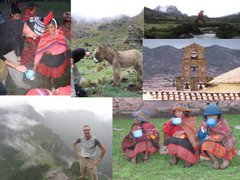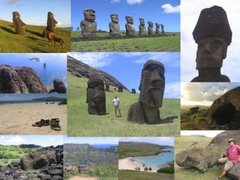(Another picture from the red fort. The guy sitting down isn't a tourist - he's a guard at the Red Fort. There seemed to be a real unspoken relationship between the two which comes out in the photograph. I took loads of pictures of these two - could have kept snapping all morning)

The train from Delhi departed at 6am, arriving into Kalka at mid-day. From there, passengers transferred to the Kalka-Shimla express. This service is world famous - at least with trainspotters. The rail-line was built in the 19th century under the supervision of the British who wanted a reliable link between their new hillstation and the Indian city of Delhi.

I've had a few bizarre rail journeys on this trip - Peruvian rail's Maccu Pichu service in particular comes to mind - but nothing like this one. The train clim
 bs almost two vertical kilometres over five hours at a maximum spee
bs almost two vertical kilometres over five hours at a maximum spee d of... wait for it, 15 miles per hour.
d of... wait for it, 15 miles per hour. To put that another way, Paula Radcliffe at marathon pace could just about have kept up with us the whole way (though, as we know she's not great in the heat - sorry, a bit harsh).
In fact, I've no doubt that marathon runners could have beaten us over the five hours. Aside from the limited top speed, the train was hampered by a tendency to stop for five to ten minutes at each station. After a few stops I realised that his was to give local vendors the opportunity to foist food-stuffs on the passengers and in fact, the passengers seemed only to pleased to take up the opportunities.

After a while I wondered whether the main purpose of the train was to get from A to B or just to provide a mobile picnic. And remember, this was the 'Express' service.
(Right - if this picture gives you an impression of a Sunday picnic trip rather than a serious train service, it's not misleading!)
When the train was moving - which wasn't often - one great feature was that the doors at either end of the carraige were open and you could hang out as far, and for as long and as often, as you wanted. It's often said that we've lost so much in the western world's rush to capitalism and 'modern' society.
As far as I'm
 concerned, the ability to hang out of moving trains is one of those things. Less facetiously, there is a serious point here - what we often now lack in the west is a sense of individual responsibilty. The 'nanny state' has robbed us of much that makes life exciting.
concerned, the ability to hang out of moving trains is one of those things. Less facetiously, there is a serious point here - what we often now lack in the west is a sense of individual responsibilty. The 'nanny state' has robbed us of much that makes life exciting.Overall, I loved the whole thing. Perhaps being a fan of train travel helps - I always find long-distance train trips relaxing. On this occassion I arrived both chilled out and well fed.
So... Shimla. Shimla was a hill-station established by the British in the first half of the 19th century as a 5-month-a-year retreat from the stifling heat of the Indian summer. Its hey-day was at the end of that century when for 50 years, the British ruled one-fifth of the world's population from a collection quaint colonial houses in the mountains.
Within a couple of hours of arriving it was clear to me that the place has gone steadily downhill since then (that's the problem with having a hey-day), which is ironic as I spent some considerable time going steadilly uphill to get there.
To start with the positives, the location is phenomenal - a thickly forested mountain top with dramatic valleys rolling off in a dozen different directions and snow-capped peaks in the distance. 100 years ago this must have been an awesome location for hillwalking and sheer escapism. But not now. It's hard to state how poorly the place has been developed so I'm going to borrow someone else's words:
If someone had told me that Shimla had been built by a bunch of intelligent monkeys i would have said 'what a remarkable group of monkeys, they must be shot before they can do it again.'
(Right: Shimla town planners argue over a planning application.)
And that was a hundred years ago. God knows what that guy would say now. Poorly built and stupendously ugly buildings have sprung up everywhere, spoiling every view and generating noisy traffic from which there is little escape, even on the 'pedestrianised' high street. On top of all this, most of the colonial biuldings still standing have been allowed to go to ruin.

Maybe this all sounds a bit snobbish or precious and in point of fact the place was absolutely crammed with Indian holidaymakers - this is school holiday season in India.
If you concentrate really hard, and have a sturdy pair of earplugs, it is still possible to look beyond the town itself and imagine the fantastic views without the ugliness, especially at sunset. But, when compared to hill-stations in Malaysia's Cameron Highlands, it's a real shame to see how Shimla has completely lost its charm.
I had planned to head further into the hills to McLeod Ganj, home of the Dalai Lama, but faced with a 10 hour bus journey and after the Shimla experience, I've now decided to head west, to the Golden Temple at Amritsar, just shy of the border with Pakistan.
I have a feeling this phenomenal sight will kindle my love for India.












1 comment:
An excellent blog with great description of the train experience from Kalka-Shimla express. Yes, lack of planning has taken away the charm of Shimla. That is increasingly true of many tourist destinations in India. We have provided a link from ourTravelpaisa - Budget Accommodation to your blog. You will find the same in Blogs section.
Post a Comment